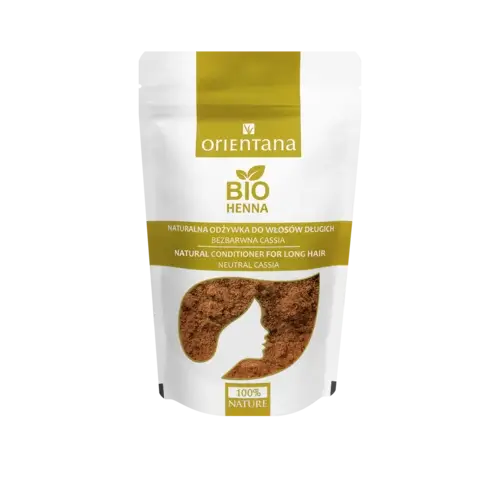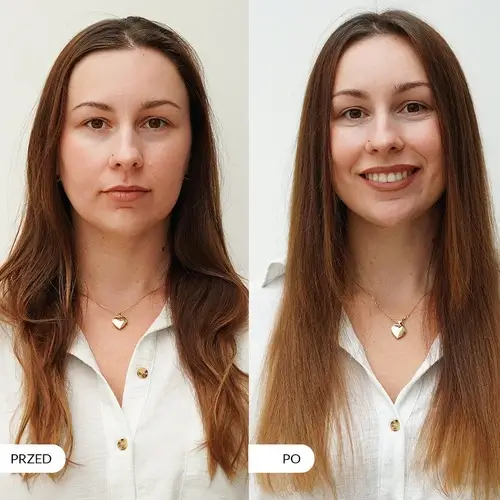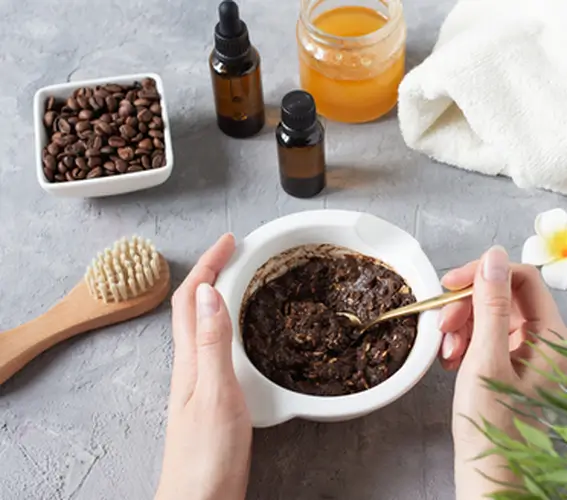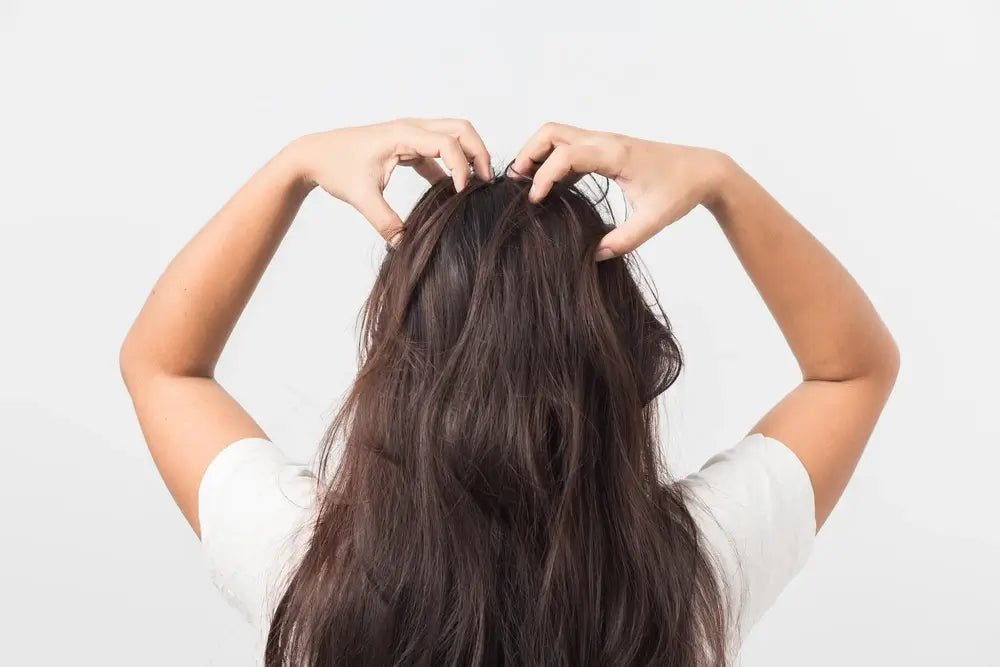Scalp peeling is a real hit in care, which is gaining more and more recognition - and it's no wonder! Its main goal is to remove dead skin, which not only refreshes the scalp, but also strengthens the hair. Regular use of this treatment can make the skin healthy and refreshed, and well-cleansed skin is prepared to better absorb nutrients such as hair oils or rubs . Peeling can also be a solution to problems such as dandruff, excessive greasiness or persistent itching.
There are various types of scalp peels available on the market, such as mechanical, enzymatic, and acidic. Mechanical peels contain exfoliating particles that physically remove dead skin. Enzymatic peels work on the basis of enzymes that gently dissolve dead skin cells. Acidic peels use acids that effectively cleanse the scalp.

Orientana has a special product for you - not only is it a natural peeling but it is also a peeling that is a hair conditioner. You can find this product HERE.
What does scalp peeling do?
Scalp peeling is an effective skin care treatment that allows for exfoliation, deep cleansing of the skin and improvement of the hair condition. Regular use of this treatment helps to combat problems such as dandruff, excessive oiliness or persistent itching.
Scalp peeling is not only a way to improve the condition of the scalp but also a method to improve blood circulation. Thanks to this, it has a beneficial effect on the health of hair follicles and stimulates the growth of new hair. Regular use of peeling, supported by oiling or rubbing can bring many benefits. First of all, it will more effectively reduce hair loss and soothe scalp irritation. The nutrients used after peeling will restore the natural balance of the skin.
Regular cleansing makes your skin healthier, reducing the risk of skin problems and supporting natural, healthy hair growth.
Types of peelings
Choosing the right peel is key to effective care and achieving the desired results. There are various types of peels available on the market, each of which has its own specific properties and applications. Among the most popular you will find:
- mechanical peelings,
- enzymatic peelings,
- acid peels,
- enzymatic-mechanical peelings.
Each of these types affects the skin in a different way.
Enzymatic peeling
Enzymatic peeling for the scalp is an ideal solution for people with sensitive and delicate skin. It contains plant enzymes such as papain and bromelain, which gently dissolve dead skin cells without causing irritation. Thanks to its mild formula, this type of peeling is safe even for the most demanding skin. If you want subtle but effective care, enzymatic peeling will be a bull's eye. If you irritate your skin, panthenol is an excellent remedy.
Mechanical peeling
Mechanical peeling works by physically exfoliating dead skin cells with abrasive particles. This method provides deep cleansing and works even on dry skin, provided that after the head massage with peeling, you use an oil or a rub containing moisturizing ingredients. If you need intensive cleansing, removal of impurities or excess sebum, mechanical peeling will be an excellent choice. After the treatment, the skin becomes refreshed and better prepared for the next stages of care.
Acid peeling
Acid peeling for the scalp is a great option for people struggling with oily skin. It contains AHA or BHA acids, which effectively soften the epidermis and regulate sebum secretion. Thanks to this, the acid peeling not only thoroughly cleanses the scalp, but also helps maintain the hydrolipid balance.
How to use a scalp scrub?
Exfoliating your skin is easy. Apply the right amount to your skin, according to the instructions on the packaging. Gently massage your skin in circular motions. Leave the exfoliation on for a few minutes to allow the ingredients to work. Rinse thoroughly to remove any residue.
An important way to apply a peeling is a head massage. During such a procedure, microcirculation improves, which promotes better absorption of active ingredients used after peeling. The improved blood circulation achieved during the massage not only supports skin health, but can also stimulate hair growth. Therefore, massage is often recommended as a complement to peeling.
How often should I use a scalp scrub?
The frequency of exfoliation depends on the individual needs of your skin. The standard frequency for most people is once a week or every two weeks. If you have oily skin, you can exfoliate more often to control excess sebum. Limit the frequency if your scalp is sensitive. Observe how your skin reacts and adjust the care rhythm to its needs.
Should I exfoliate my scalp before or after washing?
The choice between dry and wet peeling depends on the type of product and the expected effects. Use enzymatic peeling on dry skin – enzymes work more effectively in a dry environment. Use mechanical peeling on wet skin – abrasive particles cope better with impurities on wet skin.
Active ingredients
Active ingredients in scalp peels are key to their effectiveness and gentleness. The most commonly used include exfoliating AHA and BHA acids, exfoliating plant enzymes, natural substances such as Indian clay and various plant extracts that cleanse and nourish the skin. Each of these ingredients brings something unique to the table, supporting scalp health.
AHA and BHA acids
AHA and BHA acids are some of the most important ingredients in acidic scalp peels. They regulate sebum secretion, which is especially important for people with oily scalps, cleanse pores and help maintain skin balance. The judicious introduction of acids to your care can significantly improve the condition of the scalp.
Plant enzymes
Plant enzymes, such as papain and bromelain , are valuable ingredients in enzyme peels. They dissolve dead skin cells and are recommended for delicate scalps. They are an ideal choice for people with sensitive scalps. Thanks to their mild formula, they minimize the risk of irritation while offering effective and safe exfoliation.
Natural ingredients
Natural ingredients such as Indian clay and plant extracts are becoming increasingly popular in scalp care. Clay cleanses the skin, regulates sebaceous glands, relieves itching and improves the overall condition of the skin. Plant extracts – moisturize and nourish the scalp, supporting its health and balance. In addition to exfoliating the epidermis and cleansing the skin, they are a great way to improve blood circulation in the scalp and regulate sebum secretion.
Natural peelings that are both vegan and cruelty-free are gaining popularity in the world of cosmetics. By choosing them, we can enjoy not only effective cleansing, gentle and friendly care, but also their friendly impact on the environment.
Peelings that cleanse the scalp and care for the hair. Colorless henna.
Cassia obovata, also known as colorless henna or henna conditioner, is a plant that is gaining popularity in natural hair and scalp care. Unlike classic henna, it does not change hair color, making it an ideal choice for people who want to use its properties without worrying about changing the shade.
Applying Cassia to the scalp brings many benefits. The herbs act as natural exfoliating particles. It soothes skin irritations, regenerates the scalp, improves blood circulation in the scalp, nourishes the scalp, and helps fight dandruff. Its advantage is the regulation of sebum secretion and the promotion of healthy hair growth. It is a natural way to have healthy and well-groomed skin.
And how does Cassia work on hair? This herb is also a natural hair conditioner that strengthens hair from root to tip. Its regular use improves hair structure. Hair becomes smoother, more elastic and resilient. Cassia makes hair look healthy and fuller, loose and shiny.

How to use Cassia?
Cassia comes in the form of a natural plant powder. You need a Cassia pack, warm boiled water (approx. 50-60°C), a bowl (not metal) and a spoon. To moisturize the scalp, prepare natural yogurt.
Pour cassia into a bowl and gradually add warm water, stirring until you get the consistency of thick cream. Cassia does not require a long activation time, but it is worth leaving it for 15-30 minutes.
Apply cassia to washed, towel-dried hair. Distribute from roots to ends with a brush or your hands (wear gloves), massage the scalp with the resulting pulp. Wrap hair in cling film or put on a shower cap to prevent drying. Leave on hair for 1-2 hours. Rinse cassia with warm water until you have completely removed the remaining powder.
It is a natural scrub and conditioner in one. The Indian herb improves microcirculation, nourishes the scalp, causes hair growth, and also nourishes and smooths it. It will take care of the comprehensive condition of the scalp and hair.
Scalp problems and peeling
Dandruff, excessive oiliness or persistent itching can effectively make everyday life unpleasant. The way to deal with these problems can be regular use of exfoliators. Oily scalp is a problem that affects about 25-30% of the population. Exfoliation will help regulate sebum secretion, a key factor in the fight against oiliness,
Oily scalp will thank you for regular use of exfoliators.
Seborrheic dermatitis? This is a problem that affects about 3-5% of the population. These problems can be really annoying. Fortunately, properly selected peels can bring relief. Products containing aloe extract or panthenol have a soothing effect, reducing irritation and itching. What's more, regular removal of dead skin and excess sebum alleviates the symptoms of seborrheic dermatitis and helps improve the condition of the skin.
Homemade scalp scrubs
Preparing a homemade scrub with natural ingredients is simple and does not require specialist knowledge. You can combine clay with your favorite shampoo to obtain a scrub base. If you add ingredients tailored to your needs, e.g. honey or coconut oil, the scrub will also have a moisturizing or nourishing effect. Such a scrub will perfectly exfoliate the epidermis.

If you want to deep clean, use sea salt or coffee. Optionally, you can add a few drops of essential oil, such as tea tree, to help fight dandruff. You can also add aloe vera extract to moisturize the skin well.
A great way to remove dead skin is to exfoliate your head with coffee grounds. It not only removes dead skin but also improves blood circulation in the scalp and reduces hair loss.
After reading this, you probably already know why it is worth including peeling in your scalp care. Peeling is a simple but extremely effective treatment that can significantly improve the condition of the skin and the health of the hair. Regular use of this method brings many benefits, such as deep cleansing of the skin, removal of impurities, excess sebum and dead skin. Well-groomed skin is a good substrate for hair growth. Adding peeling to your daily care can be a breakthrough step for healthy care.






